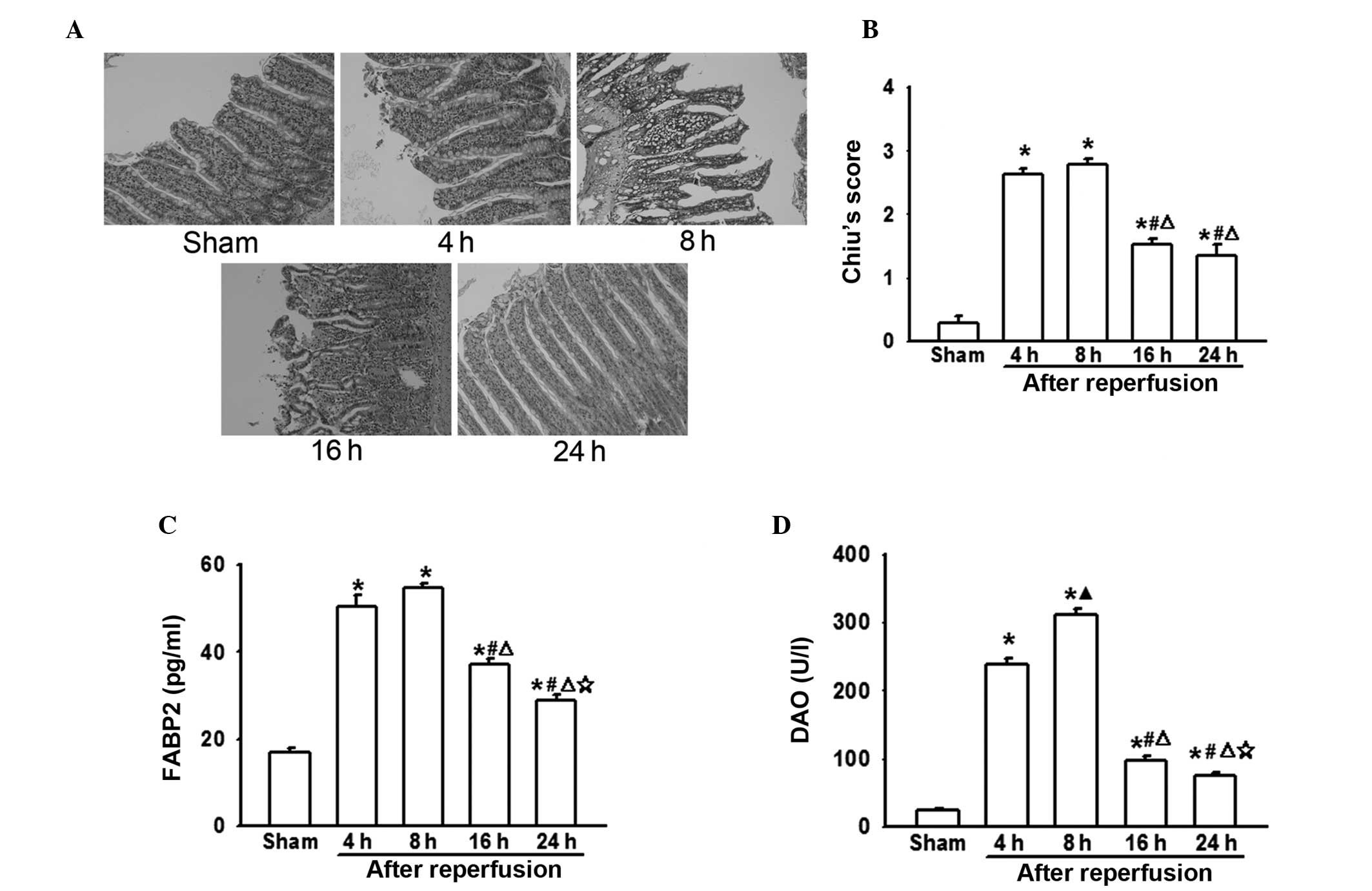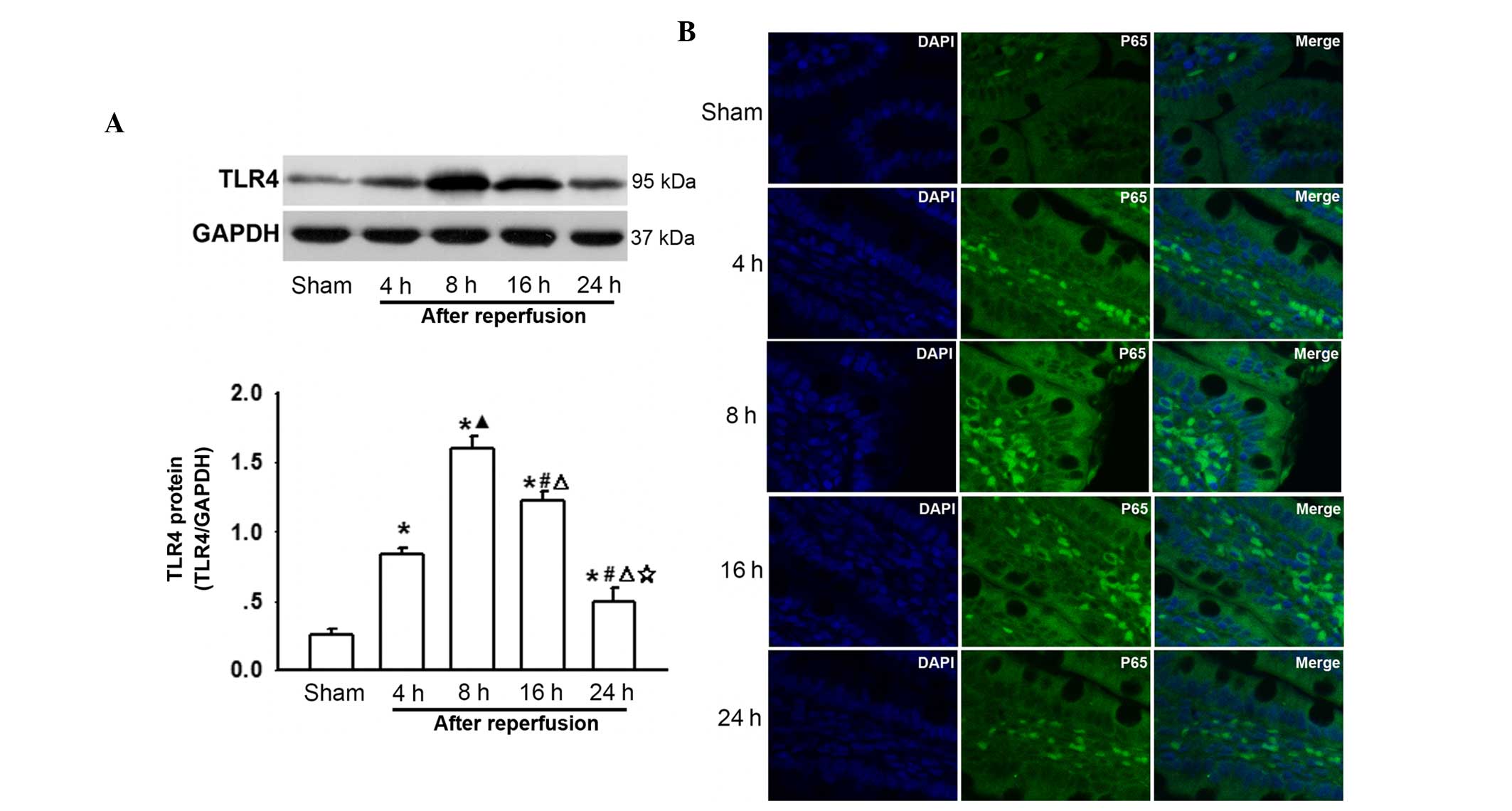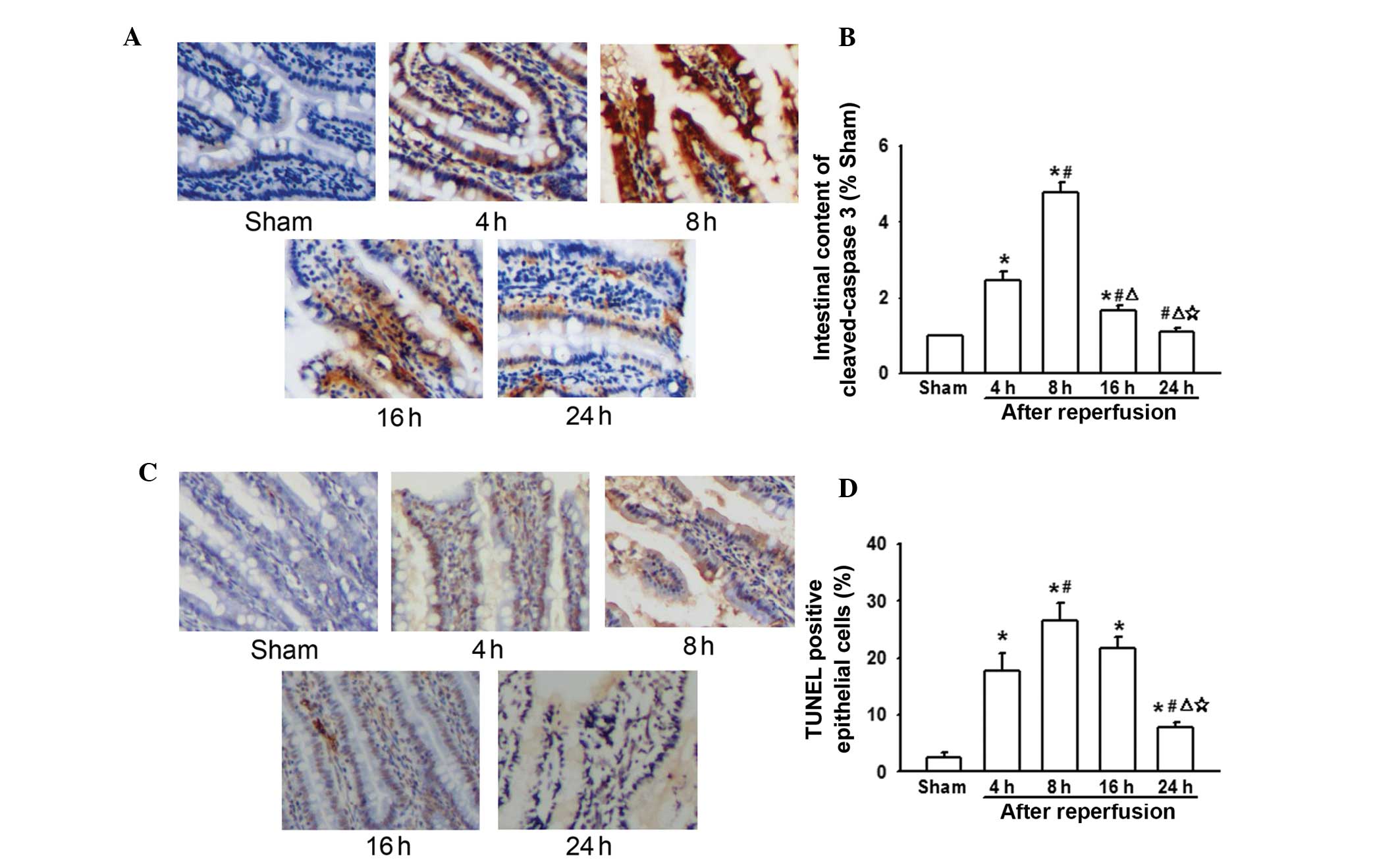|
1
|
Luo C, Yuan D, Li X, Yao W, Luo G, Chi X,
Li H, Irwin MG, Xia Z and Hei Z: Propofol attenuated acute kidney
injury after orthotopic liver transplantation via inhibiting gap
junction composed of connexin 32. Anesthesiology. 122:72–86. 2015.
View Article : Google Scholar
|
|
2
|
Ohkohchi N: Mechanisms of preservation and
ischemic/reperfusion injury in liver transplantation. Transplant
Proc. 34:2670–2673. 2002. View Article : Google Scholar : PubMed/NCBI
|
|
3
|
Ge M, Chi X, Zhang A, Luo G, Sun G, Xie H
and Hei Z: Intestinal NF-E2-related factor-2 expression and
antioxidant activity changes in rats undergoing orthotopic liver
autotransplantation. Oncol Lett. 6:1307–1312. 2013.PubMed/NCBI
|
|
4
|
Goto S, Kamada N, Moore T, Ware F, Lord R,
Kobayashi E and Kim YI: The influence of intestinal congestion on
survival of preserved liver grafts in rat liver transplantation.
Transplantation. 58:974–977. 1994. View Article : Google Scholar : PubMed/NCBI
|
|
5
|
Dai X and Wang B: Role of gut barrier
function in the pathogenesis of nonalcoholic fatty liver disease.
Gastroenterol Res Pract. 2015:2873482015. View Article : Google Scholar : PubMed/NCBI
|
|
6
|
Sanada Y, Mizuta K, Urahashi T, Ihara Y,
Wakiya T, Okada N, Yamada N, Ushijima K, Otomo S, Sakamoto K, et
al: Impact of endotoxin measured by an endotoxin activity assay
during liver transplantation. J Surg Res. 180:349–355. 2013.
View Article : Google Scholar
|
|
7
|
Li Y, Chen Y, Zhang J, Zhu JF, Liu ZJ,
Liang SY, Sun K, Liao WY and Gong JP: Protective effect of
glutamine-enriched early enteral nutrition on intestinal mucosal
barrier injury after liver transplantation in rats. Am J Surg.
199:35–42. 2010. View Article : Google Scholar : PubMed/NCBI
|
|
8
|
Luo H, Guo P and Zhou Q: Role of
TLR4/NF-κB in damage to intestinal mucosa barrier function and
bacterial translocation in rats exposed to hypoxia. PloS One.
7:e462912012. View Article : Google Scholar
|
|
9
|
Fang WF, Douglas IS, Wang CC, Kao HC,
Chang YT, Tseng CC, Huang KT, Chang HC and Lin MC: 5-Lipoxygenase
activating protein (FLAP) dependent leukotriene biosynthesis
inhibition (MK591) attenuates lipid A endotoxin-induced
inflammation. PloS One. 9:e1026222014. View Article : Google Scholar : PubMed/NCBI
|
|
10
|
Sarmiento D, Montorfano I, Cáceres M,
Echeverría C, Fernández R, Cabello-Verrugio C, Cerda O, Tapia P and
Simon F: Endotoxin-induced vascular endothelial cell migration is
dependent on TLR4/NF-κB pathway, NAD(P)H oxidase activation and
transient receptor potential melastatin 7 calcium channel activity.
Int J Biochem Cell Biol. 55:11–23. 2014. View Article : Google Scholar : PubMed/NCBI
|
|
11
|
Riehl TE, Foster L and Stenson WF:
Hyaluronic acid is radio-protective in the intestine through a TLR4
and COX-2-mediated mechanism. Am J Physiol Gastrointest Liver
Physiol. 302:G309–G316. 2012. View Article : Google Scholar
|
|
12
|
Zhang A, Chi X, Luo G, Hei Z, Xia H, Luo
C, Wang Y, Mao X and Xia Z: Mast cell stabilization alleviates
acute lung injury after orthotopic autologous liver transplantation
in rats by down-regulating inflammation. PloS One. 8:e752622013.
View Article : Google Scholar
|
|
13
|
Ohkawara H, Ishibashi T, Sugimoto K, Ikeda
K, Ogawa K and Takeishi Y: Membrane type 1-matrix
metalloproteinase/Akt signaling axis modulates TNF-alpha-induced
procoagulant activity and apoptosis in endothelial cells. PloS One.
9:e1056972014. View Article : Google Scholar
|
|
14
|
Mosbah IB, Zaouali MA, Martel C, Bjaoui M,
Abdennebi HB, Hotter G, Brenner C and Roselló-Catafau J: IGL-1
solution reduces endoplasmic reticulum stress and apoptosis in rat
liver transplantation. Cell Death Dis. 3:e2792012. View Article : Google Scholar : PubMed/NCBI
|
|
15
|
Biancofiore G, Bindi L, Miccoli M, Metelli
MR, Panicucci E, Baggiani A and Filipponi F: Balance of pro- and
anti-inflammatory cytokines in cirrhotic patients undergoing liver
transplantation. Transpl Immunol. 28:193–197. 2013. View Article : Google Scholar : PubMed/NCBI
|
|
16
|
Liboredo JC, Vilela EG, Ferrari MD, Lima
AS and Correia MI: Nutrition status and intestinal permeability in
patients eligible for liver transplantation. JPEN J Parenter
Enteral Nutr. 39:163–170. 2015. View Article : Google Scholar
|
|
17
|
Yang S, Li R, Qu X, Tang L, Ge G, Fang W,
Qiao Z, Ma J, Hou Y and Liu H: Fosinoprilat alleviates
lipopolysaccharide (LPS)-induced inflammation by inhibiting
TLR4/NF-κB signaling in monocytes. Cell Immunol. 284:182–186. 2013.
View Article : Google Scholar : PubMed/NCBI
|
|
18
|
Li PM, Li YL, Liu B, Wang WJ, Wang YZ and
Li Z: Curcumin inhibits MHCC97H liver cancer cells by activating
OS/TLR-4/caspase signaling pathway. Asian Pac J Cancer Prev.
15:2329–2334. 2014. View Article : Google Scholar
|
|
19
|
Jung DY, Lee H, Jung BY, Ock J, Lee MS,
Lee WH and Suk K: TLR4, but not TLR2, signals autoregulatory
apoptosis of cultured microglia: A critical role of IFN-beta as a
decision maker. J Immunol. 174:6467–6476. 2005. View Article : Google Scholar : PubMed/NCBI
|
|
20
|
Zheyu C and Lunan Y: Early changes of
small intestine function in rats after liver transplantation.
Transplant Proc. 38:1564–1568. 2006. View Article : Google Scholar : PubMed/NCBI
|
|
21
|
Swank GM and Deitch EA: Role of the gut in
multiple organ failure: Bacterial translocation and permeability
changes. World J Surg. 20:411–417. 1996. View Article : Google Scholar : PubMed/NCBI
|
|
22
|
Bedirli A, Sakrak O, Soyuer I and
Muhtaroglu S: Portosystemic shunt prevents apoptosis in rat
intestinal mucosa caused by total hepatic ischemia. Eur Surg Res.
36:293–299. 2004. View Article : Google Scholar : PubMed/NCBI
|
|
23
|
Zhou QQ, Yang DZ, Luo YJ, Li SZ, Liu FY
and Wang GS: Over-starvation aggravates intestinal injury and
promotes bacterial and endotoxin translocation under high-altitude
hypoxic environment. World J Gastroenterol. 17:1584–1593. 2011.
View Article : Google Scholar : PubMed/NCBI
|
|
24
|
Tanaka KA, Kurihara S, Shibakusa T, Chiba
Y and Mikami T: Cystine improves survival rates in a LPS-induced
sepsis mouse model. Clin Nutr. pii:S0261–S5614. 2014.
|
|
25
|
Guo L, Zheng Z, Ai J, Huang B and Li XA:
Hepatic scavenger receptor BI protects against
polymicrobial-induced sepsis through promoting LPS clearance in
mice. J Biol Chem. 289:14666–14673. 2014. View Article : Google Scholar : PubMed/NCBI
|
|
26
|
Huang RL, Yuan Y, Zou GM, Liu G, Tu J and
Li Q: LPS-stimulated inflammatory environment inhibits
BMP-2-induced osteoblastic differentiation through crosstalk
between TLR4/MyD88/NF-κB and BMP/Smad signaling. Stem Cells Dev.
23:277–289. 2014. View Article : Google Scholar :
|
|
27
|
Ren Z, Cui J, Huo Z, Xue J, Cui H, Luo B,
Jiang L and Yang R: Cordycepin suppresses TNF-α-induced NF-κB
activation by reducing p65 transcriptional activity, inhibiting
IκBα phosphorylation and blocking IKKγ ubiquitination. Int
Immunopharmacol. 14:698–703. 2012. View Article : Google Scholar : PubMed/NCBI
|
|
28
|
Huang L, Tang Y, Qin J, Peng Y, Yuan Q,
Zhang F and Tao L: Vasoactive intestinal peptide enhances
TNF-α-induced IL-6 and IL-8 synthesis in human proximal renal
tubular epithelial cells by NF-κB-dependent mechanism.
Inflammation. 35:1154–1160. 2012. View Article : Google Scholar
|
|
29
|
Zhang Z, Chen J, Chen L, Yang X, Zhong H,
Qi X, Bi Y and Xu K: Low frequency and intensity ultrasound induces
apoptosis of brain glioma in rats mediated by caspase-3, Bcl-2 and
survivin. Brain Res. 1473:25–34. 2012. View Article : Google Scholar : PubMed/NCBI
|
|
30
|
Dai XJ, Li N, Yu L, Chen ZY, Hua R, Qin X
and Zhang YM: Activation of BV2 microglia by lipopolysaccharide
triggers an inflammatory reaction in PC12 cell apoptosis through a
toll-like receptor 4-dependent pathway. Cell Stress Chaperones.
20:321–331. 2015. View Article : Google Scholar :
|
|
31
|
Zhou Y, Wang Q, Mark Evers B and Chung DH:
Oxidative stress-induced intestinal epithelial cell apoptosis is
mediated by p38 MAPK. Biochem Biophys Res Commun. 350:860–865.
2006. View Article : Google Scholar : PubMed/NCBI
|
|
32
|
Kim JM, Eckmann L, Savidge TC, Lowe DC,
Witthöft T and Kagnoff MF: Apoptosis of human intestinal epithelial
cells after bacterial invasion. J Clin Invest. 102:1815–1823. 1998.
View Article : Google Scholar : PubMed/NCBI
|
|
33
|
Ahn KS, Sethi G and Aggarwal BB:
Simvastatin potentiates TNF-alpha-induced apoptosis through the
down-regulation of NF-kappaB-dependent antiapoptotic gene products:
Role of IkappaBalpha kinase and TGF-beta-activated kinase-1. J
Immunol. 178:2507–2516. 2007. View Article : Google Scholar : PubMed/NCBI
|













